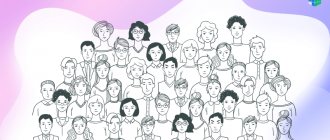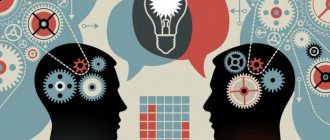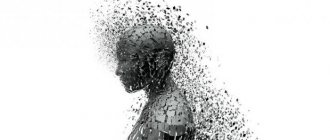Human civilization is a product of creativity, so creative individuals are always in the spotlight. Not only philosophers and psychologists, but also people far from philosophizing thought about who all these creators of masterpieces and talented scientists are, and how they differ from ordinary people. Maybe these are geniuses endowed with a divine gift, or madmen whose brains work with serious deviations? Or perhaps they are ordinary people, and the ability to create is available to everyone?
Despite serious research in the field of psychology of creativity that was carried out throughout the 20th century, there is no clear answer to these questions. But I will try to introduce you to the most common approach to understanding the essence of a creative personality.
You are open to different people and ideas
Collective intelligence researchers claim Innovation in the collective brain. : innovation is the product not of talented individuals, but of many. In other words, innovation comes from communication and the exchange of ideas.
One of the study's authors urges: if you want to be more creative, talk to people you disagree with.
You don't have to take these words literally. But if you're truly open to hearing and listening to different opinions, you're likely to have a better chance of creating something breakthrough.
Principles of interpretation of creativity (philosophical, sociological, cultural aspects)
Creativity is an attribute of human activity, its “necessary, essential, inalienable property.” It predetermined the emergence of man and human society and underlies the further progress of material and spiritual production. Creativity is the highest form of activity and independent activity of man and society. It contains an element of the new, presupposes original and productive activity, the ability to solve problem situations, productive imagination combined with a critical attitude towards the achieved result. The scope of creativity covers actions from a non-standard solution to a simple problem to the full realization of an individual’s unique potential in a certain area.
Creativity is a historically evolutionary form of human activity, expressed in various types of activities and leading to personality development. Through creativity, historical development and the connection of generations are realized. It continuously expands human capabilities, creating conditions for conquering new heights.
A precondition for creative activity is the process of cognition, the accumulation of knowledge about the subject that is to be changed.
Creative activity is amateur activity that embraces changing reality and self-realization of the individual in the process of creating material and spiritual values, new more progressive forms of management, education, etc. and pushing the limits of human capabilities.
Creativity is based on the principle of activity, and more specifically, labor activity. The process of practical transformation by man of the surrounding world, in principle, determines the formation of man himself.
Creativity is an attribute of activity only of the human race. The generic essence of a person, his most important attributive property, is objective activity, the essence of which is creativity. However, this attribute is not inherent in a person from birth. At this time, it is present only as a possibility. Creativity is not a gift of nature, but a property acquired through work. It is transformative activity and inclusion in it that is a necessary condition for the development of the ability to create. The transformative activity of a person educates him as a subject of creativity, instills in him the appropriate knowledge and skills, educates his will, makes him comprehensively developed, allows him to create qualitatively new levels of material and spiritual culture, i.e. create.
Thus, the principle of activity, the unity of labor and creativity reveal the sociological aspect of the analysis of the foundations of creativity.
The cultural aspect is based on the principle of continuity, unity of tradition and innovation.
Creative activity is the main component of culture, its essence. Culture and creativity are closely interconnected, moreover, interdependent. It is unthinkable to talk about culture without creativity, since it is the further development of culture (spiritual and material). Creativity is possible only on the basis of continuity in the development of culture. The subject of creativity can realize his task only by interacting with the spiritual experience of humanity, with the historical experience of civilization. Creativity as a necessary condition includes the adaptation of its subject to culture, the actualization of some results of past human activities.
Developed sensory sphere
A creative person is unthinkable without the widest range of feelings that he is capable of experiencing. It is impossible to create successfully or have the prerequisites for this, being an emotional “cracker”. Therefore, if you are prone to creativity, then you can probably notice a very impressive set of experiences behind you. This does not have to have clearly defined external manifestations: you can suppress your feelings - however, inside you, all the events that happen should find a very strong response.
You are easily distracted
In a sense, the opposite conclusion to the previous one was made by American scientists. According to the results of their study Creativity and sensory gating indexed by the P50: Selective versus leaky sensory gating in divergent thinkers and creative achievers. , creative individuals are more easily distracted by extraneous signals. Marcel Proust comes to mind, locking himself in a cork-lined room and wearing earplugs to work in silence.
Researchers note that increased sensitivity can be useful for creators: with its help, they can feel the world more subtly. But at what cost!
Search for new experiences
Creative individuals strive for new experiences . They love to experience them, they specifically look for them. From them creators draw material for their creations. Curiosity, the search for new sensations, emotionality, sensitivity, and developed imagination are the engine of their creative activity.
Many people use meditation to be more productive. It optimizes emotions, relieves anxiety, stimulates mental clarity, which allows you to tune in to the creative process.
Meditation
Creative personality in everyday life
It has long been known that creative individuals tend to daydream, have a developed imagination and do not tolerate routine well, and are almost unable to cope with everyday tasks. They are able to find solutions to many complex technical problems, but it is difficult for them to clean their apartment and cook food.
Scientists from the University of Auckland, New Zealand, studied the phenomenon of a wandering mind. This is a condition in which a person is absorbed in his own thoughts and reacts poorly to external stimuli signaled by the senses, or, conversely, performs routine actions unconsciously, automatically.
According to the findings of researchers from the University of Auckland, when the mind wanders, different parts of the brain are involved, which has a beneficial effect on the development of creative abilities.
Photo: pxhere.com: UGC
Intrinsic motivation
Creative people cannot help but create . This is probably their main distinguishing feature. Creativity is their state of mind, their way of life. All other things fade into the background when inspiration .
Passionate passion for work helps create masterpieces that the whole world admires
Creators are driven more by internal motivation rather than material reward. Money is a nice bonus. Typically, agents promote geniuses.
Love for beauty
Comments in the article: Tsvimadze Evgeniy Vasilievich.
Tsvimadze Evgeniy Vasilievich, director of the Institute of Theater, Film and Television of Synergy University
It is very difficult for creative people to be in unaesthetic conditions. As a rule, they strive to at least somehow transform everything around them in order to live/work/study/spend time in a relatively beautiful, pleasantly decorated environment. This could be anything: from general cleaning to artistic wall painting - however, if you are a creative person, then you will not be lazy to spend time and effort on this.
As a rule, it is important for creative people to be in a comfortable environment. And they really try to surround themselves with a beautiful atmosphere and people. But creative people are so carried away by the process itself that they simply do not have time to create this beauty around themselves at home. Often, the everyday life that surrounds them in everyday life can most likely have such a rather sloppy appearance. I've seen this a lot - what's called creative clutter. The same director who, for example, likes to have breakfast in a restaurant on the 50th floor overlooking Moscow, will have complete chaos and chaos at home. Because when he leaves after breakfast for the whirlwind of the creative process, he simply has no time for it. Evgeniy Tsvimadze
Creative personality: how psychologists interpret the concept
A creative personality in psychology is a rather controversial concept. There are at least two approaches to its interpretation.
According to one of them, any personality is creative. The ability to create new things is inherent in human nature, and creativity is an integral need for personal self-development, which consists in creating something new and meaningful, primarily for the creator himself. In other words, creativity will be both a child’s drawing made for the first time and a mathematical equation solved for the first time.
According to the second approach, a creative person is an individual who experiences a stable and irresistible need for creativity and sees in it the main meaning of his life.
Process description
In fact, no creative person has ever wondered how he manages to achieve this or that result. What did you have to endure during this sometimes very long period of creation? What stages needed to be overcome? A psychologist from Britain at the end of the 20th century, Graham Wallace, was puzzled by these questions. As a result of his activities, he identified the main points of the creative process:
- Preparation;
- incubation;
- insight;
- examination.
The first point is one of the longest stages. It includes the entire training period. A person who has no previous experience in a particular field cannot create something unique and valuable. First you have to study. This could be mathematics, writing, drawing, design. All previous experience becomes the basis. After which an idea, goal or task appears that needs to be solved, relying on previously acquired knowledge.
The second point is the moment of detachment. When long work or searches do not produce a positive result, you have to throw everything aside and forget. But this does not mean that our consciousness also forgets about everything. We can say that the idea remains to live and develop in the depths of our soul or mind.
And then one day inspiration comes. All the possibilities of creative people open up, and the truth comes out. Unfortunately, it is not always possible to achieve your goal. Not every task is within our power. The last point includes diagnosis and analysis of the result.











